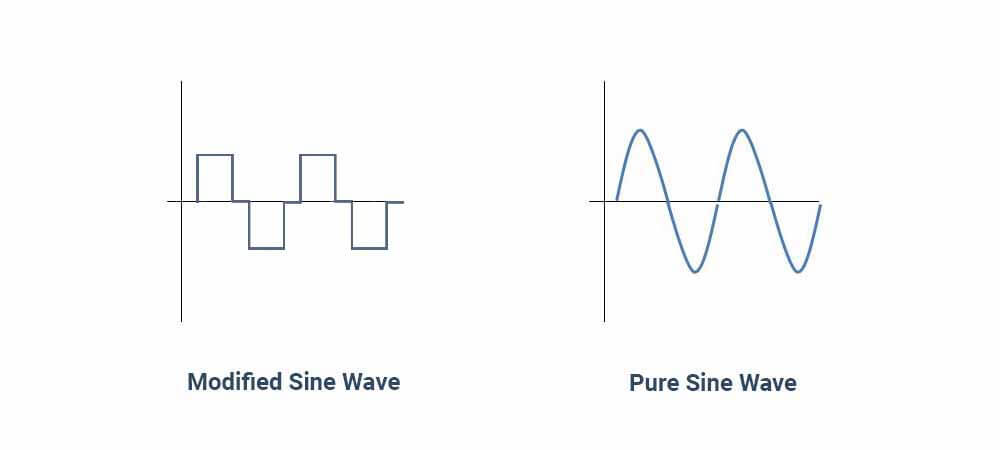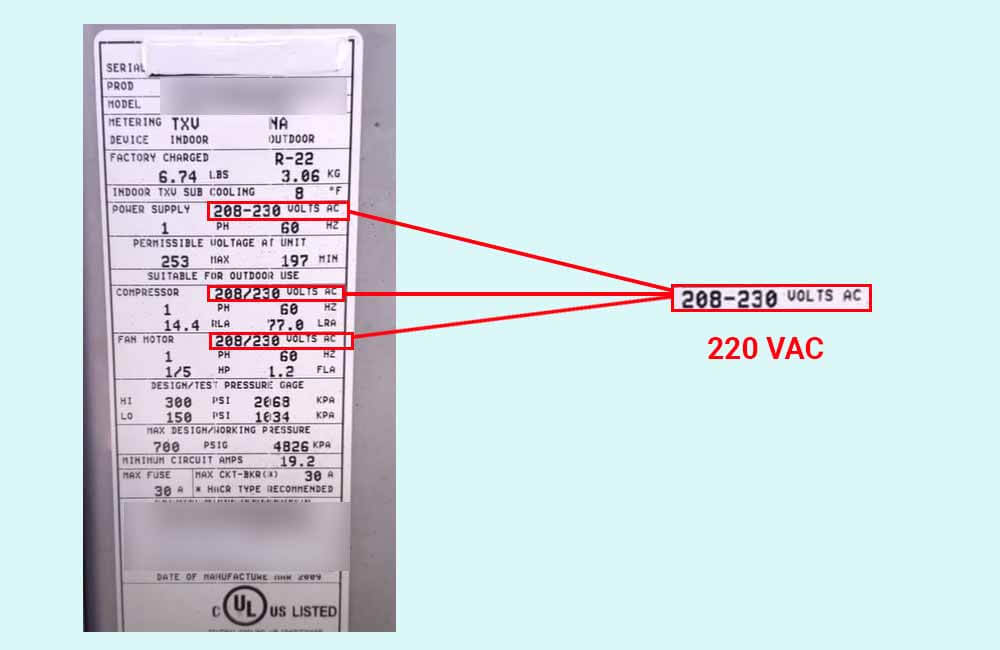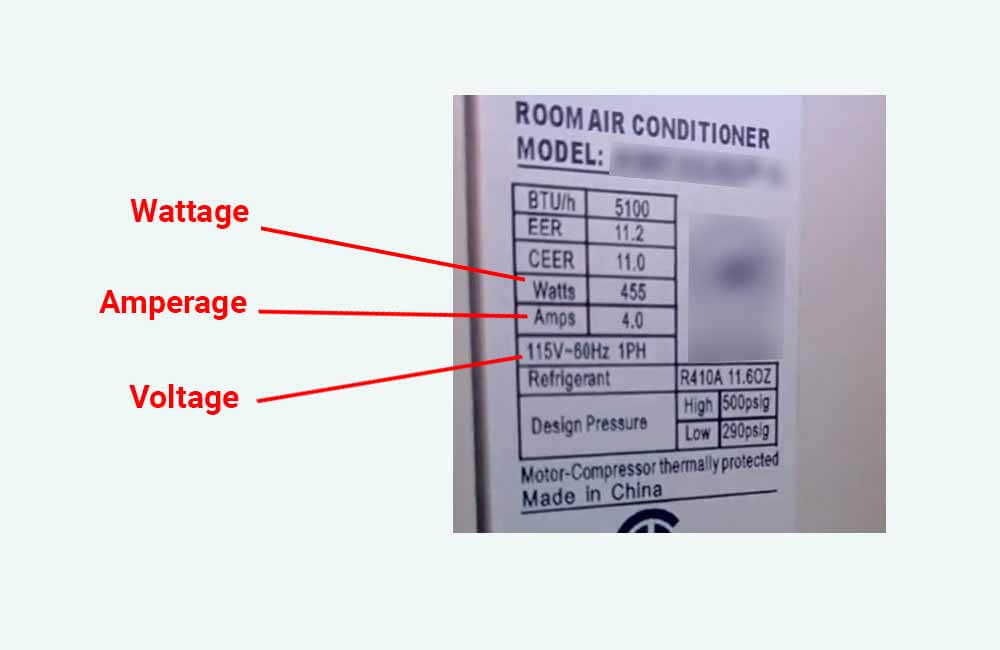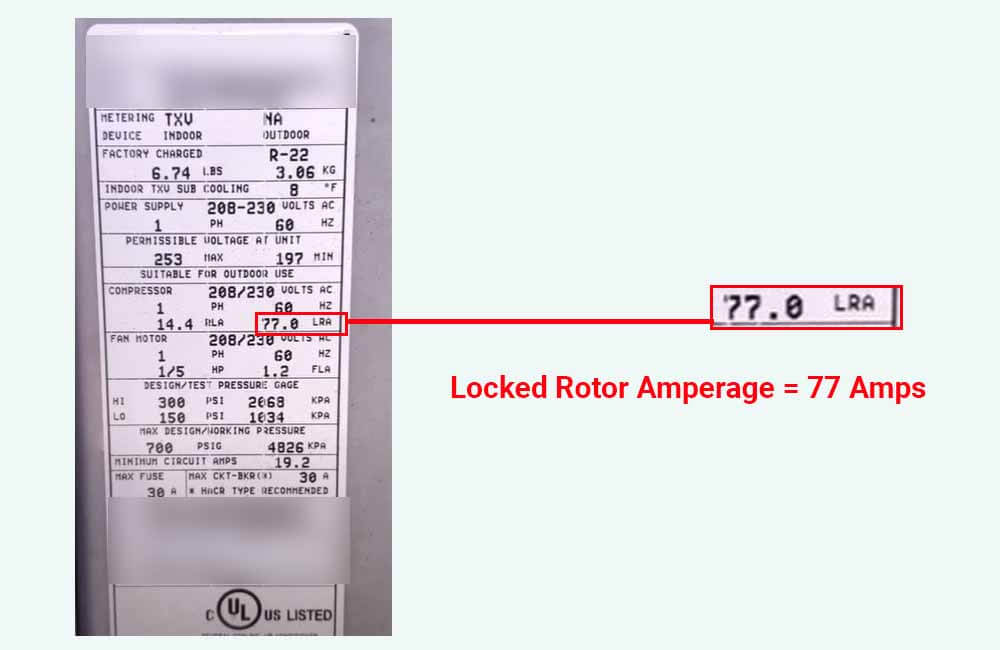The main rating of an inverter is its Continuous Power (in Watts), but with appliances such as air conditioners, refrigerators, pumps, or any device with a motor, the continuous power of an inverter is not the only rating that matters.
In this article, I’ll explain in detail the main specifications to look at when shopping for an inverter that can run your air conditioner.
I get commissions for purchases made through links in this post.
What specifications to look for in the inverter?
There are 5 specifications to look for in an inverter that can run your air conditioner:
- Continuous Power rating
- Surge Power rating
- Waveform
- Input voltage
- Output voltage
Let’s see what each of these specifications represents and how they should be matched to the specs of your air conditioner.
Continuous Power rating
This is the main rating of the inverter and is usually provided in Watts or kiloWatts.
The Continuous Power rating of an inverter represents the maximum amount of power that the inverter is capable of supplying (Outputting). For example, a 3000 Watt inverter will not be able to run a 4000 Watt load.
Sometimes, the Continous Power rating of an inverter is provided in VA (Volt-Amperes) instead of Watts, and these 2 ratings are not the same.
While Volt-Amperes represent the Apparent Power, Watts represent Real (True) Power, which is the actual amount of power that a device uses. Click here to learn more about the difference between these 2.
If you’re looking at an inverter that has a VA rating on it, make sure to look at its specification sheet to find the Continous Power rating in Watts. If the latter is nowhere to be found, you can use this simplified formula to calculate it:
Continuous Power (W) = Continuous Power (VA) x 0.8
For example, the equivalent of 3000VA is 2400 Watts.
In any case, the Continuous Power rating of the inverter you choose should be higher than the power usage of your air conditioner. Later in this article, I’ll show you how to determine the power usage of your AC unit.
Surge (peak) power rating
The power rating of an appliance indicates the amount of power (in watts) that the device requires to run. However, some appliances (such as pumps, refrigerators, and air conditioners) require 3 to 7 times their running power when they’re first turned on, this amount of power is referred to as Surge Power.
For example, consider a 5000 BTU air conditioner that has a power rating of 400 Watts. Although this air conditioner will only draw 400 Watts when it’s running, it might draw up to 3000 Watts for a brief moment when you first turn it on.
This is why inverters have a Surge Power rating which indicates how much power they should be able to supply briefly. The Surge Power rating of an inverter is 2 or 3 times its continuous power rating.
While high-frequency inverters can supply 200% of their Cont. power for a couple of seconds, low-frequency inverters can supply 300% of their Cont. power for up to 20 seconds.
For example, this high-frequency 3000W inverter from Renogy has a surge power rating of 6000 watts. On the other hand, this low-frequency 3000W inverter from AIMS can supply 9000 Watts of power for up to 20 seconds.
In the second section of this article, I’ll show you how to estimate the surge power of your air conditioner.
Waveform
As you may already know, an inverter’s job is to turn DC (direct current) power into the AC (alternating current) power that your air conditioner requires. However, the waveform of this alternating current that the inverter outputs, will depend on the type of inverter itself.
In terms of the waveform, there are 2 types of inverters on the market:
- Pure Sine Wave inverters (PSW)
- Modified Sine Wave inverters (MSW)
Now, you might be tempted to buy a modified sine inverter as they are the cheaper option, however, any appliance that has a motor in it will require a pure sine wave inverter.
To function properly, appliances that contain a motor (such as air conditioners) need the smoothest alternating voltage that they can get. Otherwise, their life expectancy will decrease and there will be additional power losses.
Contrary to MSW inverters, pure sine wave inverters guarantee the smooth output signal that your air conditioner requires:

Before even considering a particular inverter to run your air conditioner, make sure that it is a Pure Sine Wave inverter.
Input voltage
As mentioned above, an inverter converts the power out of a DC source (which will have a relatively low voltage and a high current) into AC power (which will have a relatively high voltage and low current). In this case, the DC source is the battery bank, which is usually rated at a nominal voltage of 12, 24, or 48 Volts.
Manufacturers specify the value of the voltage that the inverter is designed for, and this value is referred to as “VDC”, “DC Input Voltage”, “Nominal Input Voltage”, or simply “Input Voltage”.
If you have 2 – 12 Volt batteries wired in series, your battery bank is rated at 24 Volts nominal and you’ll need an inverter with an Input Voltage of 24 Volts. If the voltages are mismatched, the inverter will not work.
For example, let’s say I have a battery bank with a nominal voltage of 24 Volts, the actual voltage of this battery bank will depend on its state of charge and can be anywhere from 20 to 28.8 Volts.
If I attempt to run this 3000W Renogy Inverter – that has a specified DC input voltage of 12 Volts – on my 24V battery bank, it just won’t work. This is because this particular inverter is designed for voltages between 9.5 and 17 Volts, anything more than 17 Volts, and the inverter won’t turn on.
In any case, make sure that the inverter you choose has an Input Voltage that matches the voltage of your battery bank.
Output voltage
Most appliances in the U.S. run on 120 Volts, which is why the electrical outlets in homes supply 120 Volts. It is for the same reason that most inverters that are available in the U.S. will have an Output voltage rating of 120V (120VAC).
To recap., most inverters take the voltage out of the DC source (12, 24, or 48 VDC) and turn it into 120 VAC (also referred to as 110 VAC).
However, some appliances, such as dryers and central air conditioners, require a 240V supply. If this is the case for you, you’ll either need a single-phase 240V inverter or a 120/240V split-phase inverter.
If you have a small air conditioner, chances are it runs on 120V, but just in case, you’ll still need to check to voltage requirements of your AC unit.
Choose the inverter that can run your air conditioner
Now that we know the main specifications that should be considered, we need to look at the specifications of the air conditioner and find a matching inverter.
In the section above, we’ve already established that you’ll need a Pure Sine Wave inverter, but to find the right PSW inverter, you’ll need to determine these specifications:
- The voltage of the air conditioner
- Running Power of the air conditioner
- Surge Power of the air conditioner
- The voltage of the battery bank
What is the Voltage of your air conditioner?
As mentioned above, most small air conditioners (less than 18000 BTUs) run on 120V. Central air conditioners on the other hand, usually require a dedicated 220V circuit. To be sure, you can check the specification sticker on your unit.
For example, the following image is of a specification label from a 36000 BTU central air conditioner:

You can see that under the Power Supply, Compressor, and Fan Motor sections the manufacturer specifies that this AC unit uses 208 or 230 Volts. This means that the unit runs on a nominal voltage of 240V.
If this AC unit ran on 120V, it could run on a single-phase inverter with an output voltage of 120V. If your air conditioner runs on 120V, feel free to move on to the next step.
If your air conditioner runs on 240V like the one from the image above, you’ll essentially have 2 options:
- A 120/240V split phase inverter that has 2 hot wires, which could supply both 120 and 240V. An example of this would be the 4000W Inverter/Charger from SunGoldPower.
- Or a single-phase 240V inverter that has a single hot wire. A good example of this is the Growatt inverter.
Please note that if you go with the 2nd option, and want to be able to power your other 120V appliances on the same inverter, you’ll need a split-phase transformer such as this transformer from Growatt.
In any case, make sure to keep reading to learn more about the other specifications of your air conditioner.
How much power does your air conditioner use?
More often than not, manufacturers specify the power rating (watts) of the air conditioner on its technical specification label. For example, the following image is of a specification sticker from a 5100 BTU AC unit:

You can see that the manufacturer specifies 455 Watts as the power usage for this air conditioner. However, the power usage is not always directly specified. In case it isn’t, there are still a couple of easy ways to estimate that power usage:
- Use the BTU rating and the Energy Efficiency Ratio (EER) of the unit
- Use the Voltage and Amperage of the unit
Related: How many watts does an air conditioner use?
The BTU rating and EER of an air conditioner are usually provided in the EnergyGuide (yellow) label that came with the unit. The voltage and amperage of the unit are provided in the technical specification label.
1- Using the BTU rating and the EER:
The relationship between the capacity (in BTUs) and the efficiency (EER rating) of an air conditioner is represented by the following equation:
Power Rating (Watts) = BTU rating (BTUs) ÷ EER
Following our example, this particular unit is rated at 5100 BTUs and has an EER of 11.2. Using these specs, we can estimate its power rating as such:
Power Rating (Watts) = BTU rating (BTUs) ÷ EER
Power Rating (Watts) = 5100 BTUs ÷ 11.2
Power Rating (Watts) = 455.35 Watts
2- Using the Voltage and Amperage:
In general, the electrical power usage of an appliance can be calculated by multiplying its voltage and amperage:
Power Rating (Watts) = Voltage (Volts) x Amperage (Amps)
The unit from this example uses 115 Volts and 4 Amps, so its power usage can be estimated as such:
Power Rating (Watts) = Voltage (Volts) x Amperage (Amps)
Power Rating (Watts) = 115 Volts x 4 Amps
Power Rating (Watts) = 460 Watts
It is important to note that multiplying the voltage and amperage of an air conditioner will result in the apparent power (VA) of the air conditioner instead of its real power. This means that the real power rating of the AC unit is lower than this product.
This is due to something called the “Power Factor“, which you can read up more on here. The actual power rating of an air conditioner is represented as such:
Power Rating (Watts) = Voltage (Volts) x Amperage (Amps) x Power Factor
The power factor will usually be between 0.8 and 0.99 and will depend on the AC unit itself. For simplicity purposes, we’ll just use the initial equation.
According to the power usage specified by the manufacturer (and determined by our methods), this particular air conditioner uses around 455 watts of power when it is running. This means that the inverter that could run this unit needs to have a Continuous Power rating of more than 455 watts.
So, a 500W inverter should do the trick, right?
The answer is probably not.
A 500W inverter can run this unit, but it probably won’t be able to start it. This brings us to the next item on the list: The Surge Power rating.
How much power does your conditioner need to start?
Similar to refrigerators, the compressor of an air conditioner requires a relatively high amount of power to start. The starting wattage of an air conditioner can be as high as 6 or 7 times its running wattage.
For example, an 8000 BTU window AC unit might require 700 watts to run, but in some instances, it could draw up to 5000 watts (for an instant) when turned on. So how do you determine the potential starting wattage of your air conditioner?
The most precise way is to look for the Locked Rotor Amperage (LRA) of its compressor. This specification is either included on the specification label on the unit or specified on the compressor itself.
Once you find the LRA of the compressor, simply multiply its value by the voltage of the AC unit to determine the surge power:
Potential Starting Wattage (Watts) = Voltage (Volts) x LRA (Amps)
For example, here’s a specification label for a 36000 BTU AC unit:

The potential starting wattage of this air conditioner can be calculated as such:
Potential Starting Wattage (Watts) = Voltage (Volts) x LRA (Amps)
Potential Starting Wattage (Watts) = 240 Volts x 77 Amps
Potential Starting Wattage (Watts) = 18480 Watts
According to these calculations, the inverter(s) that can run this air conditioner should be able to handle a surge wattage of 18480 Watts (18.48 kW). However, please note that this is a maximum value, the surge wattage of the AC unit will likely be closer to 7-10 kW.
If the LRA is nowhere to be found, a good rule of thumb is to multiply the running wattage of your air conditioner by 6:
Potential Starting Wattage (Watts) = Running Power (Watts) x 6
For example, an air conditioner that uses 455 watts when running, might require up to 2730 watts to start.
What is the voltage of your battery bank?
The last part of this process is to make sure that the inverter you choose is compatible with your battery setup.
For example, if your battery bank consists of 4 – 12V batteries with a 2S2P configuration, the inverter must have an Input Voltage of 24 Volts. If all of these batteries are in series, the inverter should have an Input voltage rating of 48V.














Thanks alot your explanations are clear , understanding and to the point .l have learned alot from you
You gave a lot of information that I haven’t seen or read anywhere. I’d like to come back to this page and learn more wrote things down, don’t want to miss anything.
Thanks
Thanks for the info I learned a lot from the inverter and the surge power plus calculations of the AC unit. Thank you Sir.
Thank you for a great article. Your explanation made it easy to understand especially the increase in wattage at startup. Im thinking of going off the grid coz here in South Africa our government is more concerned with looting the country that fixing it. We have something called “loadshedding” which is actually blackouts that can last for up to 10 hours a day.
If the AC unit in your example has an FLA of 77, why does it not trip the 30 amp breaker it is connected to? Also, it says that the maximum circuit voltage is 19.2 amps, so how does the unit get 77 amps FLA?
Hey James,
I believe the inrush current in these air conditioners is instantaneous and does not last long enough to trip the overcurrent protection device.
I hope this answers your question.
This is very educative, Thank you.
I will love to have your direct contact for mentorship.
Thank you for this lesson in power. I have an older Motorhome, (2008). I want to do a 12v lifepo4 battery bank.
I currently have a 2000W inverter made by Xantrex. I am installing a residential fridge and I need to power a washer, Dryer, roof a/c and a basement a/c. Should I switch to a newer higher wattage inverter?
also, what size battery would you recomend? My thoughts are (4) 220 AH batteries.
I am considering OGRPHY 12V 200Ah Lithium Battery, Grade A Cells LiFePO4 Battery
I’m not sure of the voltage of the basement a/c or the dryer. I will get that info.
Thank you
Dennis
Hey there Dennis,
I think you will need a larger inverter, because washers, dryers, and air conditioners use a relatively high amount of power.
Also, the battery bank upgrade that you’re considering sounds great, but based on what you’ve described, you might need a larger battery bank.
I recommend you check out my Energy Consumption Calculator (https://www.renewablewise.com/appliance-energy-consumption-calculator/), and read up more on battery sizing here: https://www.renewablewise.com/how-to-calculate-battery-capacity-for-solar-system/
hope this helps.
I’m trying to go solar on my own slowly.
Hello Sir.
Please how do design this solar system. 2no deep freezer 130w each day use 4hours and 2no AC 1010w each duration of use 10hours. My question is which do I use in my design is it the Ac or freezer or I use both for the design.
Thank you sir
Hello Augustine,
The main concern is that the inverter should, in case it is necessary, be able to supply enough power to start both the freezer and the AC.
This means that the inverter should have a surge power rating that is greater than the surge power rating of your AC + the surge power rating of the freezer.
This means that if, for example, your freezer needs 600 Watts to start, and your AC needs 3000 Watts to start, a 2000 W with a 4000-watt surge capacity will do.
Hope this helps.
Can 3000w start up an ac only
Well it depends on the size of the AC (BTU rating), it’s type, and whether or not it has a soft starter. But for ACs under 15000 BTUs, a 3000W inverter, assuming it has a Peak Power rating of 6000W, will probably be enough.